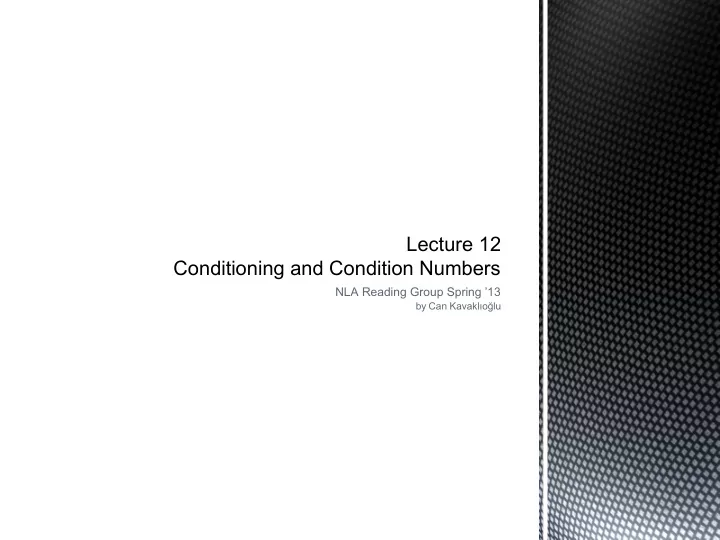

Lecture 12 Conditioning and Condition Numbers NLA Reading Group Spring ’13 by Can Kavaklıoğlu
Outline • Condition of a problem • Absolute condition number • Relative condition number • Examples • Condition of matrix-vector multiplication • Condition number of a matrix • Condition of system of equations
Notation Problem: f : X → Y Some usually non-linear, normed vector space continious function Problem instance: combination of x ∈ X and f
Problem Condition Types 1, 10, 100 10^6, 10^16 Small perturbation in f (x) Large perturbation in f (x) Small well-conditioned ill-conditioned perturbation in x
Absolute Condition Number Small perturbation in x Assuming and are infinitesimal
Absolute Condition Number If f is differentiable, we can evaluate Jacobian of f at x with equality at limit ||J(x)|| represents norm of J(x) induced by norms of X and Y
Relative Condition Number if f is differentiable,
Examples
Condition of Matrix-Vector Multiplication Problem: compute Ax from input x with fixed
Condition of Matrix-Vector Multiplication If A is square and non-singular using Loosen relative condition number to a bound independent of x If A is not square use pseudoinverse A +
Condition of Matrix-Vector Multiplication
Condition Number of a Matrix Condition number of A relative to norm || • || If A is singular
Condition of a System of Equations Fix b and perturb A, in problem:
Condition of a System of Equations
Lecture 13 Floating Point Arithmetic NLA Reading Group Spring ’13 by Can Kavaklıoğlu
Outline • Limitations of Digital Representations • Floating Point Number • Machine Epsilon • Floating Point Arithmetic • Complex Floating Point Arithmetic
Limitations of Digital Representations Finite number of bits Finite subset of real/complex numbers Two limitations • Precision: IEEE double between 1.79 x 10^308 and 2.23 x 10^-308 • Overflow / underflow • Interval representation: IEEE interval [1 2]: interval [2 4]: gap size:
Floating Point Number F: subset of real numbers, including 0 β : base/radix t: precision (23 single, 53 double precision - IEEE) integer in range exponent: arbitrary integer e fraction or mantissa Idelized system: ignores underflow and overflow. F is a countably infinite set and it is self similar: F= β F
Machine Epsilon Resolution of F: IEEE single IEEE double Rounding:
Floating Point Arithmetic Every operation of floating point arithmetic is exact up to a relative error of size at most machine epsilon
Different Machine Epsilon and Complex Floating Point Arithmetic • Some (very old) hardware may not support IEEE machine epsilon • It may be possible to use a larger machine epsilon value • Complex arithmetic is performed using two floating point numbers • Machine epsilon needs to be adjusted
The end thanks
Recommend
More recommend